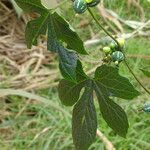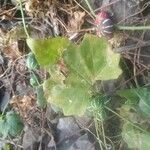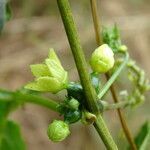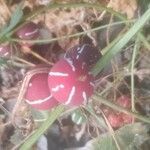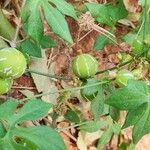Perennial climber to 6 m.; rootstock fleshy; young stems herbaceous, glabrous, becoming thickened and white-dotted on the ridges when older.. Leaf-blade broadly ovate-cordate in outline, glabrous except for a few forward-pointing aculei on the nerves beneath, gland-dotted just above the base, 38–140 mm. long, 40–148 mm. broad, palmately (3–)5(–7)-lobed; lobes linear-lanceolate to long-elliptic, usually distinctly narrowed below, entire or especially in the upper parts sinuate or subserrate with apiculate teeth, acuminate, obtuse to acute and apiculate; petiole 18–80 mm. long, armed with a few forward-curving fairly stout aculeate hairs.. Probracts spathulate, hooded, ± 3 mm. long.. Male flowers 2–8 in sessile clusters, intermixed with 0–4 ♀ flowers; pedicels 7–15 mm. long; receptacle-tube 2.5–4 mm. long; lobes subulate or filiform, 0.5–1.3 mm. long; corolla white, cream or pale or greenish yellow, with lobes 6–9 mm. long, 2.5–5 mm. broad, united below.. Female flowers 1–5, mixed with 0–8 ♂ flowers; pedicels 1–5 mm. long; ovary ellipsoid, 4.5–5 mm. long, 2.5–3.5 mm. across, deep green with longitudinal rows of white markings; receptacle-tube 1.5–2.5 mm. long, flared above; lobes subulate, 1 mm. long; corolla-lobes ± 5 mm. long and 3 mm. broad, united below.. Fruits solitary or in clusters of 2–5 on 1–5 mm. long stalks, bright scarlet with silver-white longitudinal stripes or lines of mottlings, subglobose or (but not in Africa) ovoid-ellipsoid, 16–22 mm. long, 14–24 mm. across.. Seeds 5 × 2.5–2.8 × 4 mm.
Perennial herb. Stems scandent to 6 m, glabrous. Leaf-lamina 4-14 x 4-15 cm, broadly ovate in outline, cordate, asperulous or ± scabrid-punctate above, setulose on veins beneath, otherwise glabrous, deeply palmately 5-lobed, lobes elliptic or narrowly elliptic, ± sinuate-serrate, denticulate, acuminate, obtuse to acute, apiculate, the central largest. Petiole 2-8 cm long, coarsely spiculate. Probracts c. 3 mm long, spathulate, male flowers 2-8, usually co-axillary with 1-4 female flowers; pedicels 5-15 mm long. Receptacle-tube c. 4 mm long, lobes up to 2 mm long, triangular-dentiform. Corolla white to greenish-yellow, the lobes 6-9 x 2.5-5 mm female flowers 1-5, usually co-axillary with up to 8 male flowers; pedicel 1-5 mm long; ovary 4-5 x 2-3.5 mm shortly ellipsoid. Fruits 1.5-2.5 x 1.5-2.5 cm, solitary or in clusters of 2-5, subglobose, bright red with silvery white longitudinal stripes or markings; fruit-stalks 1-5 mm long. Seeds 5-6 x 2.5-3 x 4-4.5 mm.
Perennial with thickened rootstock; stems to 6 m long, glabrous. Leaves cordate at base; lamina 3.5–13 cm long, 4–13.5 cm wide, 3–7-lobed; lobes lanceolate to elliptic, denticulate to sinuate-dentate, acuminate, glabrescent or scabrid. Male flowers in 2–8-flowered fascicles, often co-axillary with 1–4 female flowers; pedicels 5–20 mm long; hypanthium 2–4 mm long, glabrous; calyx-lobes subulate, 0.5–1 mm long; corolla-lobes ovate, 6–9 mm long, glabrous or pubescent, white or greenish; staminal filaments 1–1.5 mm long, papillose at base; disc absent. Female flowers in 1–5-flowered fascicles, often co-axillary with males; pedicels 1–5 mm long; perianth similar to male, sometimes smaller; staminodes 1 mm long; ovary ovoid, 3.5–4 mm long. Fruit in fascicles of 1–5, globose to ellipsoidal, 15–25 mm diam., glabrous, red, striped white. Seeds obovate, attenuate, 5–8 mm long, dark brown; faces thickened and pitted; margin broad.
Root tuberous. Stems slender, glabrous. Tendrils glabrous. Petiole 4-6 cm, slightly puberulent; leaf blade broadly ovate, 8-12 × 8-12 cm, membranous, palmately 5-lobed; middle lobe oblong-lanceolate, 8-10 × 2-3.5 cm, apex acuminate or obtuse; lateral lobes short, lanceolate or oblong-lanceolate, both surfaces subglabrous, sinus rounded. Male and female flowers usually fasciculate in same axil. Male flowers: pedicel slender, 5-15 mm; calyx tube ca. 2 × 5-6 mm; segments subulate, 0.5-1 mm; corolla green-yellow, ca. 7 mm in diam.; segments ovate, ca. 2 × 0.5-1 mm; stamens 3; filaments 1-1.5 mm; anthers ovoid, ca. 2 mm; anther cells reflexed. Female flowers: calyx and corolla as in male flowers; ovary ovoid, smooth. Fruit yellow-green to red, narrowly white striped, globose, indehiscent, 14-18 mm in diam., smooth. Seeds few, brown, ovate, ca. 5 × 3 mm. Fl. Mar-Aug, fr. Sep-Dec.
A herb. It is a pumpkin family plant. It is a slender climbing plant with angular stems. The stems are weak but the lower part can be somewhat woody. It can climb to 2-4 m high. The stems are angular and grooved. The rootstock is fleshy. The leaves have 3 or 5 lobes divided like fingers on a hand and are 10-15 cm wide by 6-17 cm long. There are fine teeth on the top edges of the leaves and the leaves are angular. The leaves are rough on top but smooth underneath. The leaf stalks are 3-9 cm long. The stem has tendrils which have 1 or 2 branches. Flowers are small and yellow or green. Male and female flowers are separate but often together near a leaf. Often one or two female flowers are surrounded by several male flowers. The fruit is 4 cm long and green with pale streaks along it. The leaves and stems give off a bad smell when damaged.
Leaf-lamina 4–14 × 4–15 cm., broadly ovate in outline, cordate, asperulous or ± scabrid-punctate above, setulose on veins beneath, otherwise glabrous, deeply palmately 5-lobed, lobes elliptic or narrowly elliptic, ± sinuate-serrate, denticulate, acuminate, obtuse to acute, apiculate, the central largest.
male flowers 2–8, usually co-axillary with 1–4 female flowers; pedicels 5–15 mm. long. Receptacle-tube c. 4 mm. long, lobes up to 2 mm. long, triangular-dentiform. Corolla white to greenish-yellow, the lobes 6–9 × 2·5–5 mm..
Fruits 1·5–2·5 × 1·5–2·5 cm., solitary or in clusters of 2–5, subglobose, bright red with silvery white longitudinal stripes or markings; fruit-stalks 1–5 mm. long.
Female flowers 1–5, usually co-axillary with up to 8 male flowers; pedicel 1–5 mm. long; ovary 4–5 × 2–3·5 mm. shortly ellipsoid.
Petiole 2–8 cm. long, coarsely spiculate.
Probracts c. 3 mm. long, spathulate.
Stems scandent to 6 m., glabrous.
Seeds 5–6 × 2·5–3 × 4–4·5 mm.
